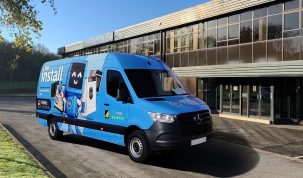
Winter 2009 was one of the most severe in over 40 years, which is good news for the heating sector. But there’s plenty to talk about in terms of design and product development too says Sarah Selzer.
The portable heating sector has long been driven by the need for distress purchases. This is not necessarily because a previous piece of equipment has broken down, but also because the vagaries of the British weather always seem to catch us by surprise.
Sales of products like fan heaters and small radiators (oil-filled and oil-free) tend to shoot up during our traditional cold snaps over the winter. When this is prolonged, or unseasonably cold, as it was this last year – the coldest for 40 years – then that has an even stronger effect on sales.
Fan heaters and convectors saw a major uplift between December 2009 and February 2010 (see GfK comment on page 33), and that does also show some determined purchasing on the part of consumers, as January had certain areas of the country grinding to a halt because of the snow.
Shifting trends
For the last couple of years we have had to look at product sectors with the additional complication of recession, either looming or actual. What has been interesting with heating appliances is that there has been a growth in prices, right across the board, eg fan heaters are up by over 3%, convectors by nearly 5% and at the more premium end, oil filled and oil-free radiators by nearly 7%.
Claire Payne, product manager for Dimplex portable heating, says there has been a shift in consumer attitude away from distress purchases on price alone and looking for added value such as timers and thermostats. “So, in spite of the recession,” she says, “we’re seeing the proof that people are prepared to pay a little more as long as they are persuaded to understand ‘you get what you pay for’. It’s a question of looking for all round value, rather than the quick fix.”
Fan heaters at under £20 represent the lion’s share of the market at over 60%. But that means there are still opportunities – 40% of them – for retailers to sell fans at between £20 and £40. This is a quick leap for the consumer to trade up to a well-known brand and with money-saving features, says Claire Payne.
Fabio Rodriguez Santiago, from UK marketing at Bionaire, says price has certainly been a key factor in the heating products sector. “There has been a significant rise in the purchase of own label products, especially as these are at the lower price points,” he says. “However, many consumers do prefer to spend a bit more on a product that has more features, better technology and is more durable.”
Energy-saving and eco friendly are certainly two sought-after adjectives in this market – and manufacturers have looked to meet that demand, particularly though not exclusively in portable heating. Bionaire has an oil-filled unit which operates on a high setting for 20 minutes then switches to low for 20, repeating the cycle while the heater is on – a so-called ‘eco mode’. De’Longhi’s Dragon and Vento ranges of oil-filled radiators both use a chimney-like system to provide a fast flow of air and so warm up a room quickly. The Cadiz eco portable radiator range from Dimplex also has rapid warm-up and Claire Payne says the current economic as well as environmental climate offers retailers a big opportunity. “Consumers are now thinking a bit more carefully about heating and the different options due to the credit crunch and rising energy costs,” she says. “Retailers can point out just how flexible and economical portable heating can be.”
Flexible solutions
Kate Rolton, De’Longhi brand manager agrees that consumers are likely to be keeping a close eye on what they spend on heating this coming winter. “’Spot heating’ with portable heating units is an economic alternative and retailers should be aware of the potential for increased sales,” she says.
“Retailers should take the time to speak to customers in depth to find out more about their heating needs so that they can recommend the best solution. For example, a fan heater for spot heating is ideal for those looking for a quick burst of heat whilst an oil-filled radiator can be used to replicate central heating if the customer wants to just heat one room that they use regularly instead of turning on central heating for the entire house.”
This is where good PoS material comes into play. Fabio Rodriguez Santiago at Bionaire says depending on the size of the retailer, help from manufacturers can come in a variety of ways. “From PoS to branded bays where you can highlight the key benefits of products and so help consumers choose the one that best suits their needs,” he says. “Online information is also extremely important, as consumers can gather the information before they even set foot into the retail outlet.”
Several manufacturers offer guidance on their own websites and De’Longhi has gone a step further by launching www.seriousaboutheating.com. This has advice on the best type of heating for a room and highlights specific advantages of the products available.
While the portable heating sector doesn’t seem to have been damaged too much by the recession and indeed seems to be making a strong recovery, it has been a more difficult task in fires. Chris Stammers, trade marketing director at Dimplex with the Glen and Dimplex brands, says it is no secret that the fires market has been challenging, as usually the purchase of a fire is linked with moving home or large-scale improvements. “Psychologists say that in times of economic uncertainty the consumer focuses on the ‘deep seated ideal’ of the home which becomes our sanctuary,” he says. “People accept that the next step up on the housing ladder will not be possible in the near future so decide to improve instead.”
This hasn’t meant that manufacturers have held back on the product development but rather have continued to improve and add to ranges, to catch whatever shrinking fortunes are out there. Says Chris Stammers: “Despite household wealth being double what it was in 1997 – about £6 trillion – we are in an era of very high levels of price sensitivity, even among those middle-class households who have taken such an extra-large slice of the new wealth that has been created.
“It means that we’re all looking for real value in terms of price and product quality which does make it hard for all of us in the industry in terms of trying to maintain our margins in such a competitive environment. But most people making a considered purchase will continue to see out retailers who deliver the service and expert reassurance.”
Recent product developments include: Dimplex adding its Opti-myst smoke and flame effects to a more compact model, the Piermont; De’Longhi with its use of ceramic technology in its Mica panel heaters; Smeg’s ‘eco friendly’ flueless natural gas and LPG fires such as the L30FAB and L23Lin (see Products to Watch); and from Burley, the Luffenham 532-R compact inset fire and the Barleythorpe 560-R which can be freestanding or inset. The company recently took on Magiglo after it went into liquidation last year and has added an electric model (see Products to Watch).
Design considerations
Design is playing an increasing role across the heating products market – it has always been influential in certain product sectors, but tailed off a little during the recession. It now seems to be back with a vengeance. Vogue UK has been offering eclectic radiators for a while now and some of its models are close to being works of art. One of its latest is the Twine, a horizontal bar at each end with a “mesmerizing tangle of rails” in-between. It is chrome-plated brass, with a 1.89W output and a price tag of £2,5
00.
But the key point is that such products encourage good design elsewhere in the market – just as the catwalks influence the high street chains in fashion. Manufacturers at whatever level they are, if they’re good at what they do, keep an eye out for what’s happening across the board. Chris Stammers at Dimplex says the skill is interpreting which trends do and don’t have to be taken into account when planning product development. “For example, what some call the ‘Faberge syndrome ‘ which is the progressive luxurification of ordinary products such as ‘bling’ phones or leather and diamante trims on everyday household objects,” he says. “This trend has passed the fires market by because a fire is a long term purchase with the main driver being the realism of the flame effects – the holy grail for buyers. A design will also remain in vogue for a period of time.”
Fan heaters and electric blankets – under the weather
Sumit Burgul, senior account manager for domestic appliances at GfK, comments:
Fan heaters and electric blankets showed volume growth of 8.9% and 5.8% respectively when comparing the year ending June 2010 to the same period a year before. Such growth is largely due to December 2009 and January 2010 hosting larger than usual seasonal sales peaks as a result of the snowfall. Indeed, these two months alone saw volume sales of fan heaters rise by 32% (compared to the December 08 and January 09) to reach 382 thousand. Fan heaters also exhibited a similar trend, growing by 36% with 443 thousand units sold during this period.
Whilst a change in weather would not be welcomed by most of us, it would, of course, present a lucrative sales opportunity for both manufacturers and retailers that specialise in heating appliances.











